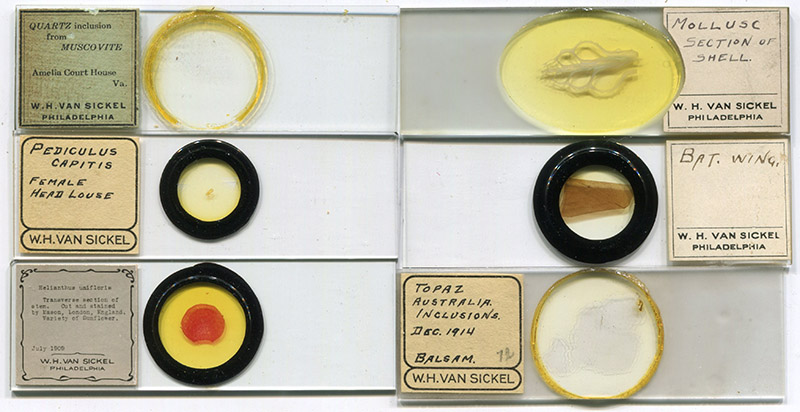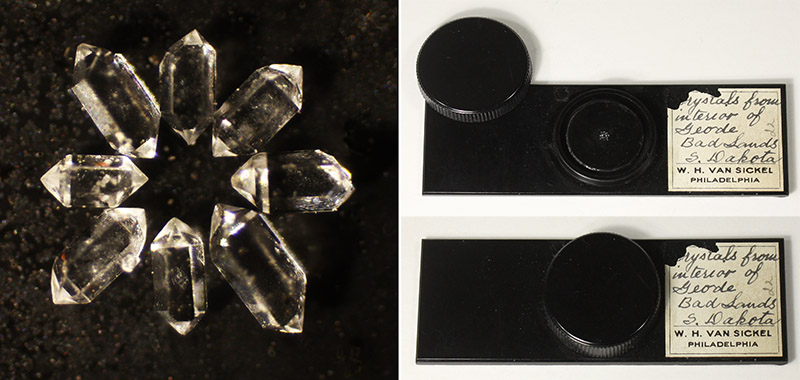Wilber Hoyt Van Sickel, 1865 - 1927
by Brian Stevenson
last updated December, 2016
This American microscopist’s slides often have a very modern look to them, although they all date from the first quarter of the twentieth century (Figures 1 and 2). Van Sickel produced a substantial number of dry-mounted preparations, mounted on black plastic with plastic removable covers (Figure 2). Although one might assume a recent date of manufacture, Van Sickel invented and began mass-producing them in 1909. That year’s Proceedings of the Academy of Natural Sciences of Philadelphia included a note, “Mr. Van Sickel devised a new form of opaque mounting slide, and, at the request of members, several thousand were manufactured from his design for general use”. They were advertised to other scientists: The Bryologist announced in 1909, “Our attention has been called to a most desirable microscopic accessory for the mounting of opaque objects. Anyone interested may obtain further information and a sample slide, by addressing Mr. W.H. Van Sickel, 2618 North 33d street, Philadelphia”.

Figure 1.
Microscope slides by Wilber H. Van Sickel, all circa 1905-1927. The thin-section mounts of molusc shell and topaz from Australia have acid-etched glass surrounding the cover slip. Details of the “Molusc section of shell” are shown in Figure 3.

Figure 2.
W.H. Van Sickel invented these plastic, covered slides in 1909. The round compression-fit lid protects the specimen from dust, and can be easily removed for examination. The base is the standard microscope slide size, 3 x 1 inch.
Wilber was born late in his parent’s lives: father Garret was 55 and mother Delia was 44. His birth came on July 27, 1865, in Decatur, Michigan, USA. Garret was a carpenter, and continued to work until his death at the age of 72. Wilber went to work while young in life, the 1880 census listing the fifteen year-old as a worker in a steel mill.
Van Sickel evidently learned advanced skills in the mill. His 1890 marriage record described him as being an “electrician”. He was later seen to be a skilled mechanical engineer. A 1927 obituary stated that Wilber, “began the study of mechanical and electrical engineering as one of the pioneers in those lines, and made his first notable success in the development of electrical power plant equipment”.
He and his wife, Nellie P. Jensen, did not have any children. They did, however, raise a boy named George Leitch (born ca. 1900), described in censuses as being a nephew.
They later moved to Cleveland, Ohio, where Van Sickel “first got acquainted with the then primary developments of the pneumatic tool”. He then moved to Brooklyn, New York, becoming manager of the Underfeed Stoker Company of America.
In 1903, reorganization of the Thomas Dallet corporation of Philadelphia, Pennsylvania, brought Wilber Van Sickel on board to be superintendent/manager. His skills helped Dallet to, “greatly extend and enlarge the capacity of their plant, located at York Street and Sedgely Avenue, and while continuing the manufacturing of their well known belt and electrically driven portable drills, deck planers, etc., will devote especial attention to the production of Dallett pneumatic tools. Their works are equipped with the latest and most improved machinery, and the extensions projected are necessary to enable them to supply the demand for the Dallett tools, which have by their intrinsic merit gained an enviable reputation”.
Over the following years, Van Sickel brought numerous patents to Dallet. In addition, he showed great skill as a salesman and dedication to his company. In 1904, the trade journal Granite reported, “W.H. Van Sickel, manager of the Thos. L. Dallett Co., Philadelphia, manufacturers of pneumatic tools, made the trip for the purpose of coming in direct contact with the trade, so that the business could be handled in a more intelligent manner. In other words, to find out what the trade wanted. The last we saw of Mr. Van Sickel he was headed for Hardwick, Vt., a drive of twenty miles and thermometer at 10 below. We hope that he arrived safely”.
At a 1907 sales convention, Van Sickel declared, “that he did not intend to take the (exhibited) tools he exhibited home, and proposed to hold a raffle, by which some dealers would secure hand tools for nothing. It was only necessary for them to sign a slip, on which was a number. There were four tools to be disposed of, and each applicant had four chances. The program was carried out as outlined, and there were gathered in Mr. Van Sickel's room, at the time of the drawing, about thirty-five retail dealers, and the occasion was one of considerable amusement and interest”.
Early during his years in Philadelphia, Van Sickel joined that city’s Academy of Natural Sciences. Although he appears to have been an active member, he left few written records. He gave presentations to his colleagues on such topics as “on a new crystallization of platinum” and “on the methods of labelling slides”, but did not publish any details.
Probably due to his working so closely with customers in stone-working trades, Van Sickel developed an interest in microscopic investigations of minerals, and prepared a large number of micromounts. His development of plastic slides with removable covers were likely a result of that interest. They permitted dust-free storage of opaque specimens, and are of a size that easily fits onto a microscope stage.
Wilber Van Sickel died on August 25, 1927, of cardiac complications.

Figure 3.
Views of the sectioned mollusc shell that is shown in Figure 1. All with crossed polarizing filters. The upper left image was photographed with an SLR camera having a polarizing filter mounted on its 50mm lens, and a second polarizing filter below the slide and above the light source. The other three images were photographed using a 3.4x objective lens and C-mounted SLR digital camera.

Figure 4.
Crystals from the interior of a geode, collected in the Badlands, South Dakota, USA. Mounted in one of Van Sickel's ca. 1909 plastic, covered slides. Left image photographed using a 3.4x objective lens.
Resources
American Stone Trade (1927) Wilbur H. Van Sickel memoriam, Vol. 28, page 68
The Bryologist (1909) Vol. 13, page 57
Death certificate of W.H. Van Sickel (1927) accessed through ancestry.com
Factory and Industrial Management (1903) Vol. 25, page vi
Foundry (1903) “W.H. Van Sickel, lately manager of the New York office of the Underfeed Stoker Co. of America, has accepted a position as superintendent of the Thos. H. Dallett Co., which is making extensive improvements to its plant at Philadelphia for the manufacture of pneumatic tools and portable drills”, Vol. 23, page 41
Granite (1904) Vol. 14, page 31
Granite, Marble, and Bronze (1907) Vol. 12, pages 22-24
Proceedings of the Academy of Natural Sciences of Philadelphia (1909) Vol. 61, page 581
Proceedings of the Academy of Natural Sciences of Philadelphia (1910) Vol. 62, page 272
Proceedings of the Academy of Natural Sciences of Philadelphia (1913) Vol. 65, page 704
US census and other vital statistics, accessed through ancestry.com
Upingtons General Directory of Brooklyn, New York City (1903) “Van Sickel Wilbur H. manager, h 16 Slocum Pl”



